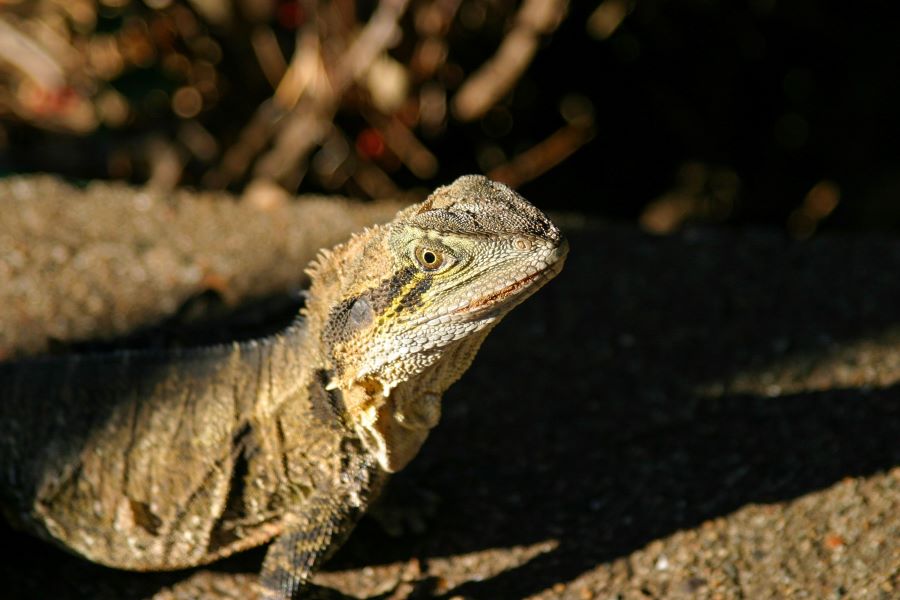Some of the posts on Mercury Pets contain affiliate links to products. That means if you click on that link and then make a purchase, we receive a percentage of the sale. We only recommend products we’ve used and support, and there’s no additional cost to you — the money goes right back into making this site the best it can be! Thanks for reading.

One of the questions I often hear when someone first gets a pet iguana is, where do they sleep? The answer can be unique for different animals, although most iguanas follow similar basic patterns of sleep behavior. This will vary depending on whether the iguana in question is a pet or is wild, but in both cases, the same kinds of sleeping habits come into play.
Iguanas will usually try to find somewhere hidden or out of the way as a place to sleep. Their normal terrain in the wild is under rocks, plants, branches, or leaves. In captivity, they may hide in a tunnel, cave, or under other materials available in their space.
A big priority for an iguana in choosing a place to sleep is finding somewhere safe and out of the way of predators. There are many factors that you might well observe in a pet iguana where sleep is concerned.
Where Iguanas Sleep
The main factors you will usually observe in where an iguana will sleep is that it may be:
- Somewhere Hidden
- Out of the way
- Underneath something
- Somewhere unexpected
- Somewhere away from heat and light
Reptiles, like all animals, are full of surprises. Your iguana may not always tick all of these boxes.
In general, iguanas are looking for somewhere out of the way. In those settings, they’re safe from predators and away from the stimulation of heat and light that keeps them awake and unable to go into the comatose state that is similar to sleep that they achieve.
Where Iguanas Sleep In The Wild
Of course, the natural world offers a wealth of infinitely random places for an iguana to choose as a resting place. Keeping in mind the five habitat features that they typically choose, the iguanas will often be found in some of the following places:
- Under objects such as leaves, rocks, or branches
- In small holes or mini-caves
- In dark places
- Somewhere well away from the obvious threat of predators
- In ‘different’ places, and not necessarily returning to the same spot again and again. This could potentially be quite dangerous for an iguana
Most iguanas live in rainforests, which give an abundance of vegetation and plants — materials that are perfect for hiding.
Rainforests are a brilliant terrain for all sorts of animals that value disguise in their lives for protection.
Where Iguanas Sleep In a Terrarium
Where you will find your iguana asleep in a terrarium will depend heavily on a few different aspects. These are issues such as:
- The size of your terrarium. Huge terrariums may give multiple options of great sleeping spots for iguanas, so you may find they sleep in many different places. Smaller terrariums may only give one or two options, so you may find your iguana becomes a creature of predictable habit.
- The features of your terrarium. Remember that iguanas are looking for somewhere safe and out of the way. If you have plants, branches, or rocks in there, you may well find these are used by your iguana.
- The sleep-friendly objects in your terrarium. Some great natural spaces include caves or bridges that offer darkness, coziness, and that feeling of being tucked well out of the way. You can buy objects such as these from pet shops or online, and they can definitely provide a great place for your iguana to sleep.

Iguanas Don’t Actually Sleep
One thing that is more of a technical point is that iguanas don’t actually ‘sleep’ in the same way that humans and so many other animals do.
Instead, they go into a state of deep rest. This state shares some features of sleep but is not the same. Their heart rates go down, and all their internal processes slow down significantly.
However, they are still in a state of awareness much different to sleep. They continue using their senses, at least to some degree, and so are aware of potential dangers and predators much more than a sleeping animal.
Where Iguanas Live
Most iguanas in the wild are found in Central and South America.
The majority of them live in rainforests. However, there are some that can be found in coastal regions of these countries, where the habitat is drier and has less vegetation.
Recreating this kind of rainforest habitat to some degree in a terrarium is the best way to witness an iguana’s natural sleep behaviors. The habitat is not only crucial to their daily waking activities but also to how they spend their time at night.
Rainforests provide shelter, protection, food and stimulation, and that is what you are aiming to reproduce.
Daily Routine Of An Iguana
Unlike many animals that will nap or sleep at intermittent periods throughout the day, an iguana’s life is structured similarly to that of a human.
An iguana in the wild will wake when the sun is up and is becoming hot. They will be most active in the daytime. This is often linked to temperature, and the hotter temperatures will allow an iguana to be most energetic.
Iguanas spend their time climbing, foraging, sourcing food, and basking in the sun.
They are generally awake for the entire day.
Iguanas will begin to sleep when it gets dark or when the temperature drops significantly. They take full advantage of any sunlight, and lighting in terrariums is crucial to their happiness and health.
They sleep in the wild when the source of heat and light is reduced. Aim for this in captivity by turning off any UV lights at night, so the iguana is experiencing a light-dark repeating cycle.
10 Top Tips For Healthy Sleep For Your Iguana
- Have some vegetation and other natural materials in the terrarium that the iguana can choose for sleep.
- Have a small cave, bridge or dark area, somewhere where they can hide away and feel secure.
- Have a light-dark cycle in place. Have the light and heat on during the day to create an active iguana, and then reduce heat and light at night.
- Create a stimulating environment that is both good in the daytime for promoting their curiosity but also provides opportunities for sleep, as well.
- Remember, iguanas don’t actually ‘sleep’ and are still slightly aware when they are in their deep-rest state.
- A larger terrarium may provide more opportunities for sleeping spots.
- Iguanas sleep at night and are awake during the day.
- Most iguanas sleep once at night and are not known for sporadic sleep and napping.
- All iguanas are different, and there is no ‘one-size-fits-all’ behavior that you are guaranteed to see.
- A ‘rainforest’ style habitat is the thing to aim for to create a happy and healthy iguana.
Conclusion
Where you will find a pet iguana sleeping is not always an exact science. Some may always choose the same place, and others will differ.
However, in general, iguanas will usually be looking for similar features in an ideal resting place. It will be somewhere out of the way and slightly hidden. It may be an unexpected place, the last place you (or a predator) would look. They like darkness, and most importantly, they like feeling safe.


